I’ve done my fair share of hitchhiking in South America. I’ve ridden on the backs of trucks in Peru and Bolivia, thumbed a lift along Chilean Patagonia’s most famous road, the Carretera Austral and even used it to get me out of a sticky situation in the remote Bolivian pampas.
I’ve hitchhiked with friends – both male and female – and, on rarer occasions, alone.
I’ve experienced hitches that have left me basking in the goodness of all of humanity and others that have genuinely resulted in me being stunned and seriously questioning the sanity of other human beings.
But, on the whole, my experiences have been positive, fascinating and, most importantly, safe.
Two years ago, I’d never hitchhiked before in my life.
Before I hitchhiked in Bolivia for the very first time, the idea of thumbing a lift was filed away under “not a chance” in my list of planned activities for my life.
For me, hitchhiking was inseparably linked with the prospect of being murdered, turned into sausages or any of the other consequences that films had persuaded me were inevitable if I hitched a lift with a stranger.

But I’ve learned to love hitchhiking. I’ve realised that not only is it considered a very normal way of travelling in some parts of the continent, but hitchhiking in South America is a unique, safe and completely unmissable part of the South American travel experience.
Along my own journey, I’ve met a lot of people who are keen to hitchhike but don’t really know where to start; I’ve met others who are as scared as I first was before I took the plunge.
Wherever you are in terms of hitchhiking experience, this article aims to give you all of the tools, and the empowerment, to give it a go. I’ve included advice from my time spent hitchhiking in South America as well as tit bits from other travellers that I’ve picked up along the way.
Hitchhiking rule #1: Learn about the country first
This is the absolute golden rule for hitchhiking in South America. Not all countries have a similar attitude towards hitchhiking.
In my experience, the following are safe and easy places to hitchhike:
- Argentina
- Chile
- Uruguay
In these three countries, for many local people hitchhiking is their only form of transport beyond public transport. As a result, expect to see lots of local travellers in this country getting around using hitchhiking.
Information for hitchhiking in Argentina, Chile and Uruguay
Argentina
- Hitchhiking is so normal in this country that there are actually Facebook groups dedicated to it which help would-be hitchers coordinate with truck drivers and other travellers.
- Truckers very regularly stop to pick up hitchhikers, particularly if you get yourself into petrol stations or other places with a high volume of traffic.
Chile
- Hitchhiking in Chile is one of the easiest ways to get around, particularly for short distances. It’s not recommended in Santiago or other large cities but in rural areas, it’s perfectly normal and you might even find people are too keen to offer you a lift – I’ve had to turn friendly drivers down when I was actually just trying to go for a walk!
- Along the Carretera Austral and parts of Patagonia where there are lots of visitors, expect to be picked up by the ubiquitous red 4×4 rental trucks. These are normally driven by local and foreign tourists.
- Outside of Patagonia you supposedly have better luck heading north, so anywhere from Puerto Montt up to the border with Peru along Route 5 should be full of opportunities for hitchhiking.
- Bear in mind that many companies have now fitted their trucks with GPS systems that record stops en route – and to discourage drivers from picking up hitchhikers. It’s still possible to get a lift with a lorry though; you can be lucky and still get picked up along the road (as I experienced), however, it is better to base yourself at a petrol station or a toll booth as trucks will be stopping there anyway.
Uruguay
- I’ve not personally had any experience of hitchhiking here, but I’ve heard that particularly on Routes 9 and 10 along the coast, it’s likely you’ll find other holidaymakers with space in their car who’ll pick you up.
- Uruguay is a very safe country to travel in and is culturally very similar to Argentina, so I wouldn’t be surprised if a lot of truckers pick hitchers up here too.
Types of vehicles: Large trucks/lorries, pickups and plenty of cars willing to pick you up too.
In other parts of South America you can hitchhike, and again, it’s seen as perfectly normal by local people. However, there is a real difference in terms of the types of hitchhiking you can do.
In rural areas in the following countries, you’ll find large trucks (camiones) willing to pick you up:
- Bolivia
- Ecuador
- Peru
Information for hitchhiking in Bolivia, Ecuador, Peru
Bolivia
- Hitchhiking in Bolivia normally takes the form of camiones where all of the locals pile into the back and find a space either sitting on the floor or standing clinging onto the sides.
- I’ve personally had lifts with all sorts of trucks (those with huge water containers, others with empty gas canisters) and you’re normally expected to pay a few bolivianos for the ride.
- You’ll probably also share the journey with other locals as this can sometimes be the only form of transport available to people.
- Hitchhiking in someone’s car doesn’t happen here and I personally wouldn’t try it. Here and in other parts of South America where the culture remains fiercely misogynistic, hitchhiking doesn’t feel as safe.
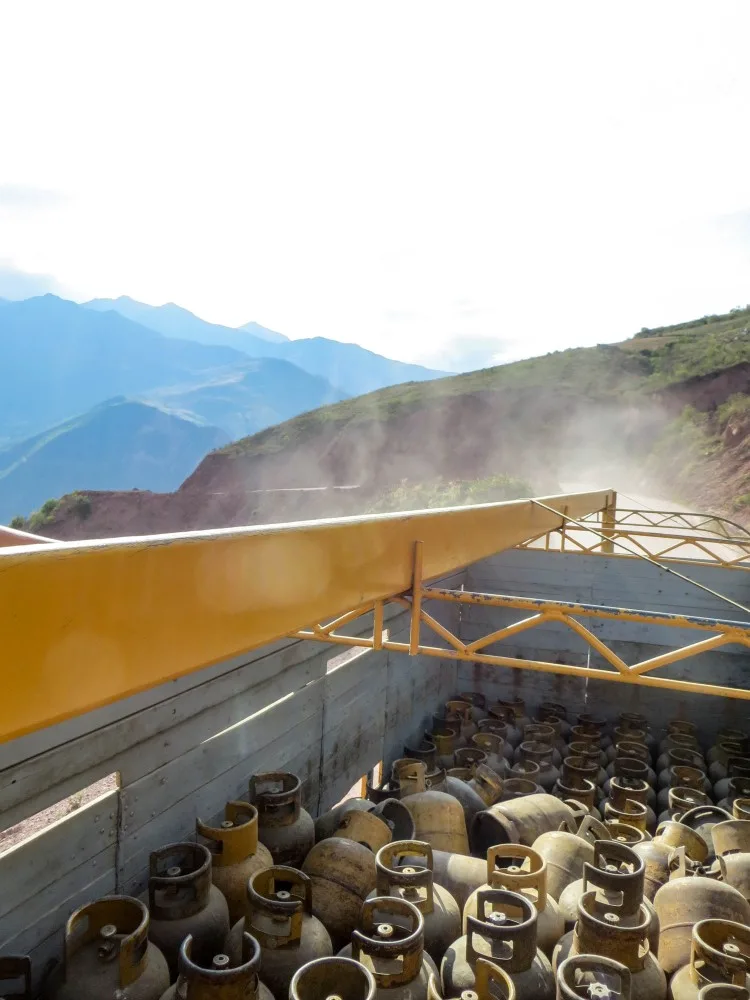
Peru
- As above with Bolivia. I’ve only experienced hitchhiking in Peru in the southern Andes.
Ecuador
- I’ve not hitchhiked in Ecuador but have been told that it’s easy enough to get a hitch in the back of someone’s pickup truck.
Types of vehicles: Smaller trucks and maybe pickups.
Places I would not recommend hitchhiking in South America
Again, I’ve had no personal experience of hitchhiking in Brazil but I’ve been told by a lot of other travellers that it isn’t safe and nor is it the best idea.
If you’ve had any experiences of hitchhiking here or in other countries such as Paraguay, Venezuela and the Guianas then please get in touch as I’d love to hear about your experiences.
Top tip for hitchhiking in South America: Speak to local people, such as the staff in your hostel or other people you meet, about whether hitchhiking in their country is something they would personally do.
If they so no, you know it’s not a great idea, regardless of what other travellers might have told you.
Hitchhiking rule #2: Be careful and follow your gut instinct
This is the most important rule of hitchhiking in South America and one that I can’t stress enough: follow your gut instinct. If it doesn’t feel safe or right, get out of the car.
Or, even better, don’t get in there in the first place.
Case in point: when I was hitchhiking along the Carretera Austral with a friend, we had received a series of lifts taking us from Puyuhuapi along the road to Coyhaique and were a couple of hours away from our final destination. We had been waiting a few hours and were praying for a final lift to get us back to the town before night-time.
Finally, we had some luck: one of the workers from the construction site a bit further up was heading all the way back to Coyhaique to he allowed us into his car.
It was only once we’d sat down and he’d begun driving did he inform us he didn’t have any brakes – and proceeded to prove it by fruitlessly pressing on the brake pedal.
Unsurprisingly, I wasn’t best pleased that he hadn’t mentioned this before we’d got into the car, and after he’d made a sandwich while driving and nearly steered into the side of the road, we parted ways at the next town.
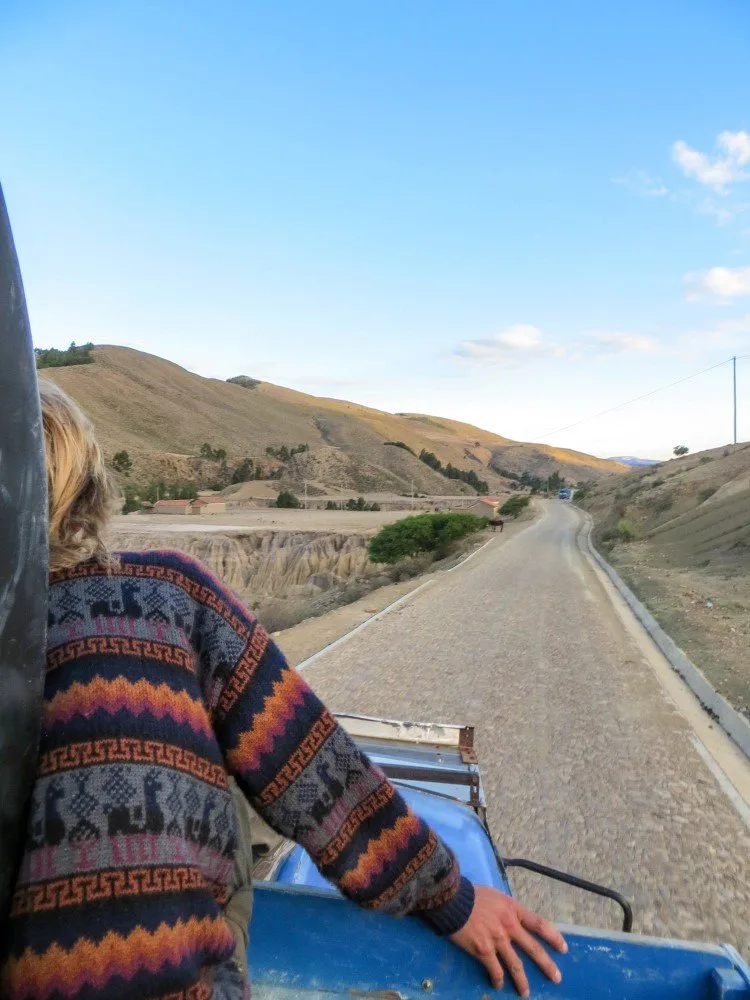
While this story was moderately entertaining, hitchhiking in South America – and anywhere across the world for that matter – can be downright dangerous. You are putting your life in the hands of a stranger and some of them, as my sandwich-making friend illustrated, have different ideas about safety.
But, for women in particular, it’s important to consider your personal safety when you hitchhike.
A fellow solo traveller I met in Bolivia told me how she’d been hitchhiking all the way from Colombia and that she’d learned that the best way to stay safe was to make a point of engaging the (normally male) driver in conversation so that they would see her as a person, not just a solo woman.
I was appalled. If you ever feel the need to prove that you’re an actual human being when hitchhiking, then you really shouldn’t be in that car in the first place.
Ultimately, if you don’t get a good vibe when you talk to the driver, don’t get in.
If you feel uncomfortable or unsafe at any point, ask to be dropped off at the next convenient place and wait for another lift.
The bottom line for hitchhiking is you should never risk your life for the sake of a lift, particularly in a continent where bus travel is so affordable that it’s an easy alternative.
Top tip for hitchhiking in South America: Ask the driver where they’re going first rather than telling them where you’re headed. That way, if anyone has any unscrupulous intentions and so would agree to whatever destination you say just to get you into the car, you’ve avoided accepting their offer of a lift.
Hitchhiking rule #3: Pick up some Spanish
While it’s not necessary to be completely fluent when hitchhiking in South America, having enough Spanish to at least communicate is not only useful for organising the lift but makes the whole experience more interesting and enjoyable.
Bear in mind that many people pick up hitchhikers because they’re bored and want to chat. It can be hard maintaining a conversation in another language for a few hours (something to consider before you start hitchhiking), but it’s only fair that you repay the person’s kindness by giving them someone to talk to on the journey.
It’s also a wonderful way of getting to know some truly fascinating people and hearing a different perspective on the country than you normally would.
On a side note, I’ve had plenty of adventures thanks to learning Spanish in South America, so I would recommend picking up at least a small amount regardless of whether you’ll be hitchhiking!
Top tip: Learn how to ask where someone is going (¿A dónde va?) and pick up a few personal questions, such as: What is your name? (¿Cómo se llama?), where are you from? (¿De dónde es usted?) and do you have a family? (¿Tiene una familia?). It’s also useful to know that hitchhiking is “hacer dedo” in Spanish.
Hitchhiking rule #4: Find the perfect spot for hitchhiking
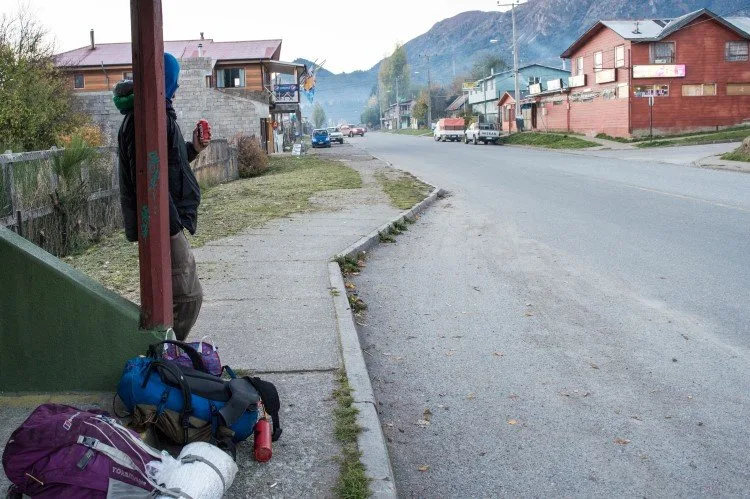
It might sound obvious, but finding a good spot is the difference between getting a hitch and standing cold and lonely by the side of the road for a long time. The main principles of finding a successful hitchhiking spot include:
- You’re more likely to get a long-distance hitch from the edge of a town than in the middle of nowhere.
- As previously mentioned, places like toll booths and petrol stations are also a good bet, particularly the latter where you’ll find plenty of truck drivers who you can even chat to before choosing to get into their vehicle.
- Try and get away from other hitchhikers on the road. Along the Carretera Austral in Patagonia, I know that the biggest problem during summer, when most attempt to hitchhike there, is stiff competition. Try to give yourself a bit of space from everyone (and don’t be a dick: follow decent hitchhiking etiquette and let the person who’s been there the longest take the first ride).
- Stop somewhere safe. Think about how easy it is for the driver to slow down and pick you up without causing a traffic accident or running you over. If you’re somewhere rural, this is probably not an issue but if hitchhiking on larger roads in South America then you need to be more careful.
Top tip for hitchhiking in South America: Wherever you’re stood, make eye contact with drivers and smile, even if they don’t stop. A lot of the time you’ll receive apologetic looks from those who can’t pick you up because they don’t have any space. But don’t get dispirited: your lift will be along soon enough!
Hitchhiking rule #5: Find the ideal number (and gender) of companions
I’ve been told on several occasions that the magic number for hitchhiking in South America is two: well, two girls. Apparently, as two women, you’ve got the best chance of a lift as you’ll find a lot of drivers concerned about you and more likely to pick you up.
I’ve hitchhiked in Chile as both a solo female, a pair of girls and with a guy; on each occasion, I’ve had very few issues being picked up. Your biggest problem is that once you start getting beyond two or three people it does become a lot more difficult to get a hitch.
In countries where you’re travelling in the back of the truck, this shouldn’t be a problem, but for in-car hitchhiking, any more than two in your group can seriously limit your chances.
That said, we managed to hitchhike successfully (and very illegally) as five people in Chiloé, Chile, so you never can tell what your luck will be.
Top tip for hitchhiking in South America: If travelling with a larger group, split into pairs or threes for your best window of opportunity. You probably won’t end up arriving at the same time but it’ll definitely increase your chances of success.
Hitchhiking rule #6: Consider bringing a “mobile home”
Part of the fun of hitchhiking is the fact that you’re never quite sure where you’ll end up that evening.
For this reason, I’ve found having a lightweight tent an indispensable tool for when I’ve hitchhiked.
More often than not, it’s acted purely as peace of mind knowing that if I don’t make it exactly to where I hope, I’ll still have somewhere warm and dry to spend the night.
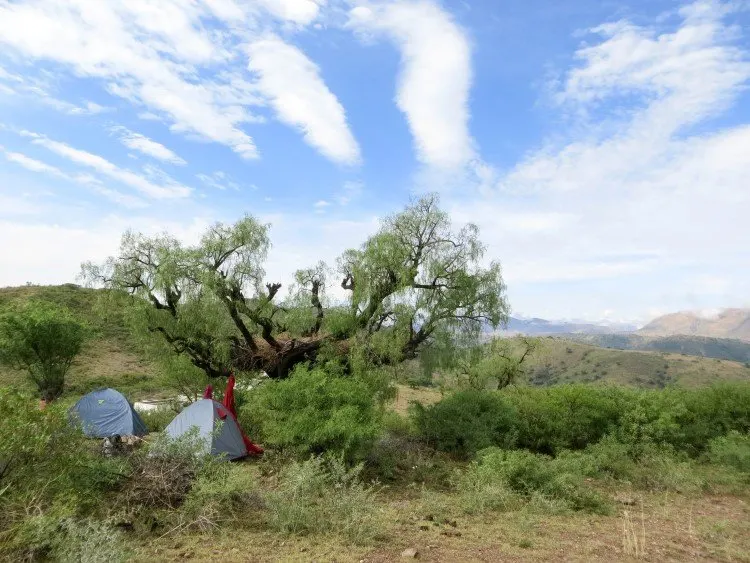
If you plan on hitchhiking for long distances in South America, you genuinely will find a tent invaluable. There are often huge distances between towns and even villages and there’s never any guarantee you’ll find a local person’s house, let alone an actual hostel to put you up for the evening.
Plan ahead and a lightweight cooking stove and some food that you bought in the last town could be the difference between a miserable, cold night and a comfortable wild camping experience in some of the planet’s most dramatic landscapes.
Did you find this article useful and inspiring? Share it with other travellers: PIN ME!
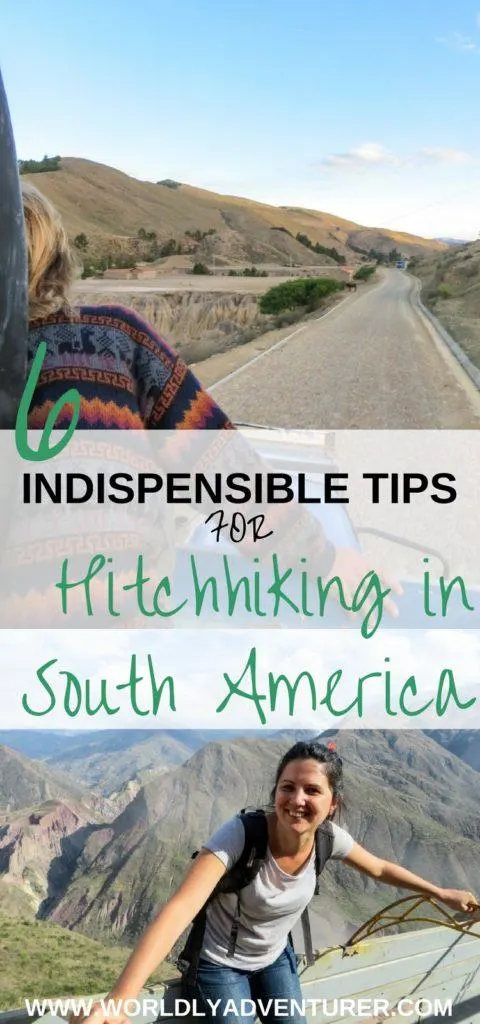

Linda
Sunday 22nd of November 2020
Hi Steph, thanks for a great article and the inspiration! I have never been to South America, although it's always been a dream. This is something I would absolutely love to do, but have been a bit hesitant as I would be a solo-traveler and I am not familiar with the culture. My thoughts at the moment is to maybe volunteer somewhere for a little while to get my feet wet and then start moving around. Which country would you recommend I start with (and is there a volunteer program you would recommend)? Or alternatively, where does one find a trustworthy hitchhiking partner :)'
Steph Dyson
Sunday 6th of December 2020
Hi Linda, I started out my time in South America volunteering and it's a great way to learn the language and really get under the skin of the region! Loads of recommendations in this guide about volunteering. Good luck!